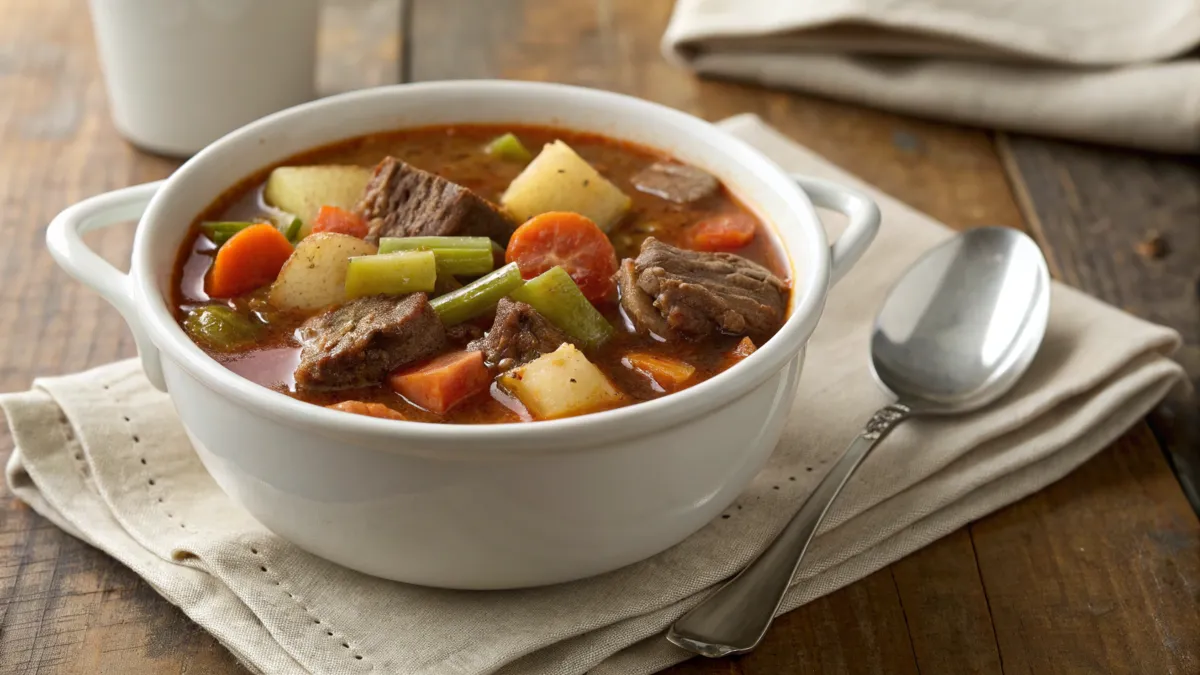There’s something magical about a warm, hearty bowl of old-fashioned vegetable beef soup recipe. It’s a dish steeped in tradition, bringing together the rich flavors of tender beef and vibrant vegetables. Whether you’re looking to warm up on a chilly evening or create a nostalgic family meal, this recipe hits the spot every time.
In this guide, we’ll walk through the history of this classic dish, share essential tips for preparing it perfectly, and explore some creative variations. By the end, you’ll have everything you need to whip up a delicious pot of homemade goodness. Let’s dive in!
Table of Contents
Old Fashioned Vegetable Beef Soup
What Makes It Old Fashioned?
An old fashioned vegetable beef soup recipe stands out because of its simplicity and traditional ingredients. This dish harks back to a time when families relied on pantry staples and fresh garden vegetables to create hearty meals.
Unlike modern versions that might use shortcuts, this recipe focuses on slow cooking to develop deep flavors. The result? A soup that feels like a warm hug on a cold day.
Why People Love This Classic Recipe
This soup’s appeal lies in its perfect balance of comfort and nutrition. Here’s why it remains a favorite:
- Wholesome Ingredients: Loaded with beef, vegetables, and a flavorful broth, it’s as nutritious as it is satisfying.
- Versatile and Budget-Friendly: You can adjust the ingredients to match what you have on hand, making it a great choice for families.
- A Crowd-Pleaser: Whether you’re cooking for a large gathering or just yourself, this soup fits any occasion.
It’s no wonder this timeless recipe has been passed down through generations, earning its spot as a beloved classic.
Ingredients for Old Fashioned Vegetable Beef Soup
Key Ingredients
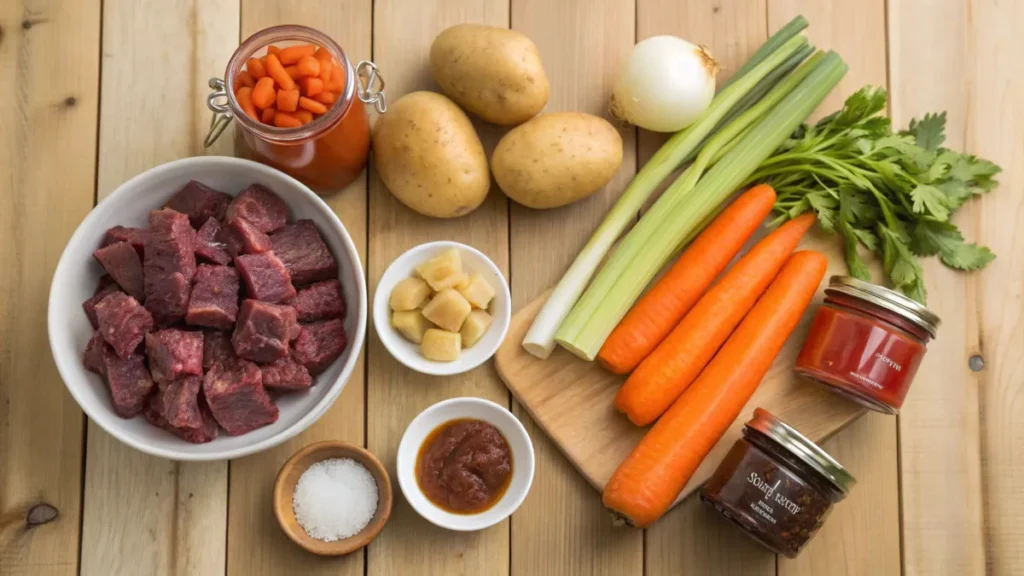
The success of an old fashioned vegetable beef soup recipe depends on its simple yet flavorful ingredients. Let’s start with the essentials:
- Beef: Use chuck roast, stew meat, or even short ribs for a tender texture and rich flavor. Browning the meat before adding it to the soup helps deepen the taste.
- Vegetables: Classic options include carrots, celery, onions, potatoes, and tomatoes. Fresh produce works best, but frozen or canned can save time.
- Broth: Beef broth or stock is the heart of this soup. You can use store-bought or homemade, depending on your preference.
- Tomatoes: Crushed or diced tomatoes give the soup a robust, slightly tangy base.
- Seasonings: Garlic, bay leaves, thyme, salt, and pepper bring everything together.
Optional Add-Ins for Extra Flavor
While the traditional recipe keeps things simple, there’s room to add your own twist:
- Grains: Barley, rice, or quinoa can make the soup even heartier.
- Beans: Kidney beans or green beans add a new layer of texture and nutrition.
- Herbs: Fresh parsley or dill makes a lovely garnish.
For more inspiration, check out Simply Recipes’ guide to seasonal soups.
Step-by-Step Recipe for Vegetable Beef Soup
Preparation Steps
- Prep the Beef: Start by cutting the beef into bite-sized chunks. Season with salt and pepper.
- Chop the Vegetables: Dice the carrots, celery, onions, and potatoes evenly to ensure they cook at the same rate.
Cooking Instructions
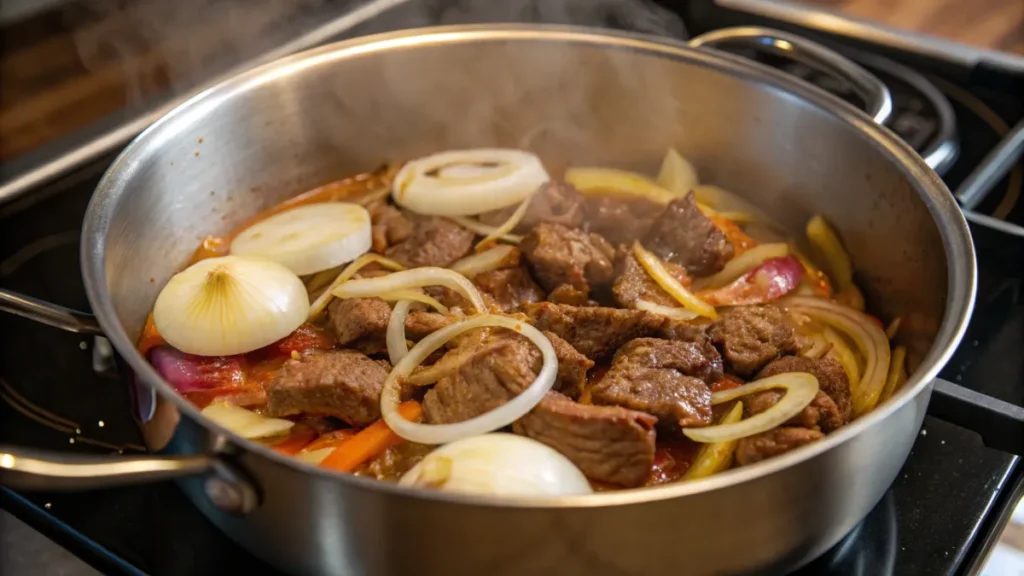
- Brown the Meat: Heat oil in a large pot and sear the beef until browned on all sides. Remove and set aside.
- Sauté the Vegetables: Add onions, carrots, and celery to the same pot. Cook until softened, about 5 minutes.
- Build the Broth: Return the beef to the pot, add the tomatoes and broth, and stir. Bring to a boil, then reduce the heat to a simmer.
- Simmer Slowly: Add potatoes, bay leaves, and thyme. Cover and let it cook gently for 1.5 to 2 hours until the beef is tender.
Finishing Touches
- Season to Taste: Before serving, taste and adjust the salt and pepper.
- Garnish: Sprinkle fresh parsley on top for a pop of color and flavor.
For more tips, explore AllRecipes’ techniques for cooking hearty soups.
Tips for Perfect Old Fashioned Vegetable Beef Soup
Common Mistakes to Avoid
When making an old fashioned vegetable beef soup recipe, even small missteps can impact the flavor and texture. Here are a few pitfalls to watch out for:
- Overcooking the Vegetables: Vegetables like carrots and celery can become mushy if cooked too long. Add them in stages to avoid overcooking.
- Using the Wrong Cut of Beef: Tough cuts like chuck roast are perfect for slow cooking. Lean cuts can turn dry and chewy.
- Skipping the Browning Step: Browning the beef before adding it to the soup adds a rich, deep flavor that can’t be missed.
Secrets for Enhanced Flavor
Want to take your old fashioned vegetable beef soup recipe to the next level? Try these tips:
- Slow Simmer for Depth: Let the soup simmer on low heat for at least two hours. This slow cooking process helps blend the flavors beautifully.
- Add a Splash of Acidity: A little vinegar or a squeeze of lemon juice brightens the broth and balances the flavors.
- Include Fresh Herbs: Toss in fresh parsley, dill, or thyme toward the end for a pop of freshness.
For more soup-making techniques, check out this guide on slow-cooking soups.
Variations of Vegetable Beef Soup
Classic Variations
The beauty of an old-fashioned vegetable beef soup recipe is its flexibility. You can easily adapt it to suit your preferences. Here are some popular variations:
- Southern-Style Vegetable Beef Soup: Add okra or black-eyed peas for a Southern twist.
- Hearty Grains: Stir in barley, rice, or quinoa for a filling, nutritious meal.
- Extra Heat: A pinch of red pepper flakes or diced jalapeños adds a spicy kick.
Healthy Adjustments
If you’re looking for a lighter or healthier version, consider these options:
- Lower Sodium Broth: Opt for reduced-sodium beef broth to control salt levels.
- Leaner Beef: Use ground beef or lean stew meat to cut back on fat.
- More Veggies: Add zucchini, spinach, or kale for extra fiber and nutrients.
For more comforting soup ideas, explore the Purple Black Bean Soup Recipe on Charmed Recipes.
Serving Suggestions and Storage Tips
Best Ways to Serve
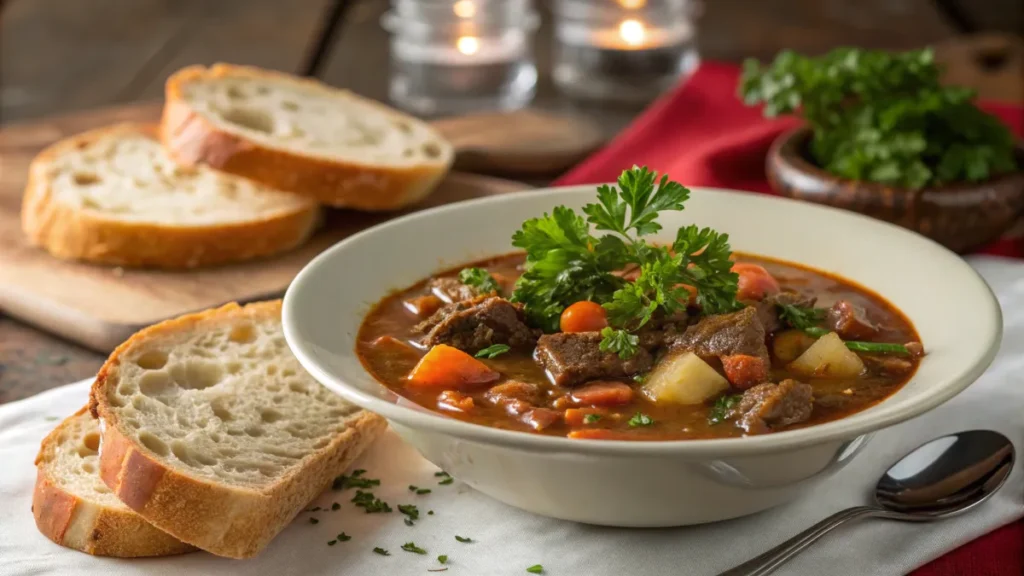
The old fashioned vegetable beef soup recipe is a versatile dish that can be served in many delicious ways. Here are a few ideas:
- With Crusty Bread: Serve the soup with a warm, crusty loaf of bread for dipping.
- Topped with Cheese: Sprinkle some grated Parmesan or cheddar on top for added richness.
- Paired with a Side Salad: A fresh, green salad complements the hearty flavors of the soup.
For a comforting meal on a cold day, ladle the soup into big bowls and enjoy it by the fire. It’s simple, satisfying, and perfect for sharing.
How to Store and Reheat
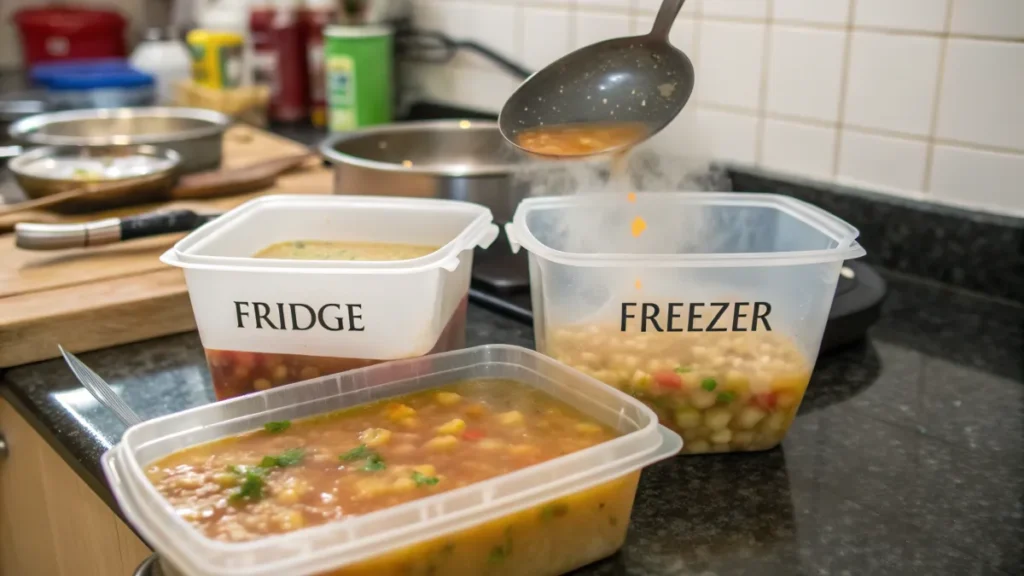
This old fashioned vegetable beef soup recipe is ideal for making ahead, as the flavors often get better over time. Here’s how to store it:
- Refrigeration: Allow the soup to cool completely before transferring it to an airtight container. It will stay fresh for up to 3 days in the fridge.
- Freezing: For longer storage, freeze the soup in individual portions. Use freezer-safe containers, and leave a little space for expansion. It can last up to 3 months in the freezer.
When it’s time to reheat, simply warm the soup on the stovetop or in the microwave. Add a splash of water or broth if it’s thickened during storage.
Frequently Asked Questions (FAQs)
What is the best cut of beef for vegetable beef soup?
For an authentic old fashioned vegetable beef soup recipe, chuck roast or stew meat works best. These cuts are affordable and become tender when cooked slowly. Avoid lean cuts, as they may turn dry during simmering.
Can I make this soup in a slow cooker or Instant Pot?
Yes! Both methods work well. For a slow cooker, brown the beef first, then add all ingredients and cook on low for 6-8 hours. For an Instant Pot, use the sauté function to brown the beef, then pressure cook for about 30 minutes.
How can I thicken vegetable beef soup?
If you prefer a thicker soup, you can mash some of the potatoes or add a slurry made with cornstarch and water. Stir it in during the last 10 minutes of cooking.
Can I make this recipe vegetarian or vegan?
Absolutely! Substitute the beef with hearty vegetables like mushrooms or eggplant. Use vegetable broth instead of beef broth for a plant-based version.
Nutritional Information
Understanding the nutritional value of an old fashioned vegetable beef soup recipe can help you enjoy it guilt-free. Here’s a simple breakdown:
| Ingredient | Serving Size | Calories | Key Nutrients |
|---|---|---|---|
| Beef (Chuck Roast) | 3 oz | 210 | Protein, iron |
| Carrots | 1 medium | 25 | Vitamin A, fiber |
| Potatoes | 1 medium | 110 | Potassium, vitamin C |
| Celery | 1 stalk | 10 | Fiber, antioxidants |
| Beef Broth | 1 cup | 15 | Sodium, minerals |
| Tomatoes (Diced) | 1/2 cup | 20 | Vitamin C, lycopene |
Key Takeaways
- This soup is high in protein and essential vitamins, making it a nutritious option.
- Adding more vegetables like zucchini or spinach can boost the fiber content.
- Opting for low-sodium broth can make it heart-healthier.
With its balanced nutrition and hearty ingredients, this old-fashioned vegetable beef soup recipe is the perfect choice for a wholesome meal.
How to Customize Your Old-Fashioned Vegetable Beef Soup
Seasonal Adjustments
The beauty of an old-fashioned vegetable beef soup recipe is how adaptable it is to the seasons. Here’s how to adjust it year-round:
- Spring: Add fresh peas, asparagus, or leeks for a lighter touch.
- Summer: Toss in zucchini, corn, or green beans for a fresh and vibrant flavor.
- Fall: Include butternut squash, sweet potatoes, or parsnips for an earthy twist.
- Winter: Opt for heartier ingredients like barley or lentils to make it extra comforting.
Creative Flavor Twists
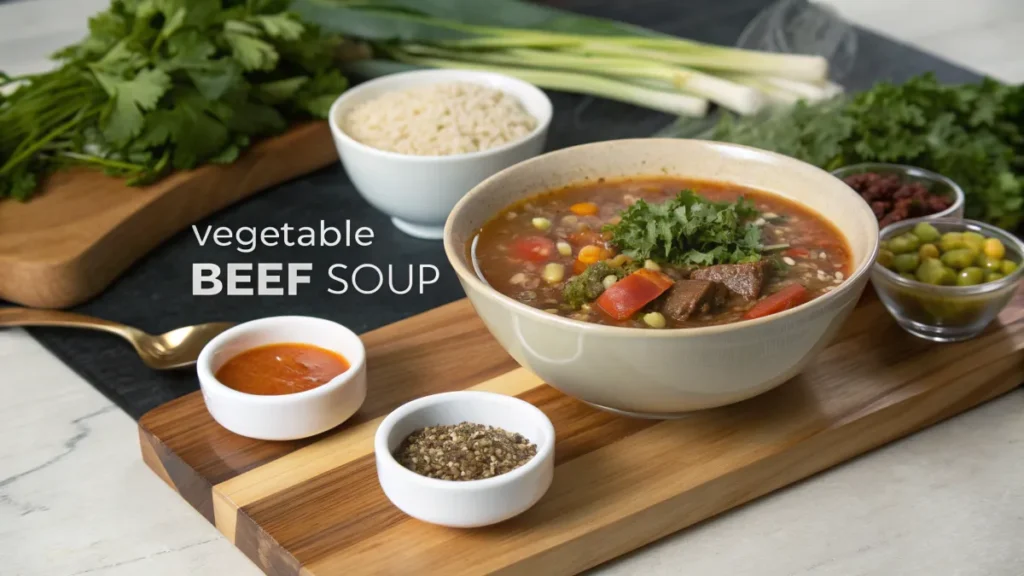
Take your recipe to the next level with these ideas:
- Add Heat: Stir in a dash of hot sauce or cayenne pepper for a spicy kick.
- Global Variations: Try soy sauce and ginger for an Asian-inspired twist or oregano and basil for an Italian flavor.
- Herb Butter Drizzle: Melt butter with fresh herbs and drizzle it over the soup before serving.
Tools and Equipment You Need
Must-Have Kitchen Tools
Preparing the perfect old fashioned vegetable beef soup recipe is easier with the right equipment:
- Large Soup Pot: A heavy-bottomed pot helps distribute heat evenly for slow cooking.
- Sharp Knife: For dicing vegetables and trimming the beef.
- Wooden Spoon: Ideal for stirring without scratching your cookware.
Nice-to-Have Gadgets
Though not essential, these can save time and effort:
- Immersion Blender: Perfect for partially blending the soup if you want a creamier texture.
- Instant Pot: Speeds up cooking while retaining all the flavors.
- Soup Ladle: Makes serving neat and easy.
Investing in these tools ensures that making your old-fashioned vegetable beef soup recipe is as enjoyable as eating it.
Common Soup Issues
Why Is My Soup Too Thin?
If your soup ends up too watery, you can:
- Simmer Longer: Allow the soup to reduce for a thicker consistency.
- Add a Thickener: Mix a slurry of cornstarch or flour with water and stir it into the soup.
What If My Soup Is Too Salty?
Don’t worry here’s how to fix it:
- Add a Potato: Drop a peeled potato into the pot; it will absorb some of the salt.
- Dilute with Broth: Add more unsalted broth or water to balance the flavors.
Anticipating and addressing these issues ensures your soup turns out just the way you want.
Old Fashioned Vegetable Beef Soup for Special Diets
Gluten-Free Adaptation
Making this old fashioned vegetable beef soup recipe gluten-free is simple and delicious:
- Swap Regular Flour: Use cornstarch or gluten-free flour as a thickening agent.
- Check Your Broth: Ensure the beef broth is labeled gluten-free. Some store-bought options may contain hidden gluten.
- Add Gluten-Free Grains: Try quinoa or wild rice instead of barley for added heartiness.
Low-Carb or Keto-Friendly Options
For those watching their carbs, this recipe can easily be adapted:
- Skip Starchy Veggies: Replace potatoes with cauliflower florets or rutabaga.
- Increase Protein: Add extra beef or even some bone marrow for richness and nutrients.
- Use Low-Carb Broth: Some broths may have added sugars choose carefully or make your own.
Vegetarian and Vegan Versions
Yes, you can make a plant-based version while keeping it hearty and satisfying:
- Replace Beef with Mushrooms: Use portobello or cremini mushrooms for a meaty texture.
- Opt for Vegetable Broth: Create a rich base with onions, garlic, and herbs.
- Add Legumes: Include lentils, chickpeas, or black beans for protein and substance.
This flexibility makes the old-fashioned vegetable beef soup recipe suitable for everyone, regardless of dietary needs.
Adding More Flavor to Your Vegetable Soup is Easy with These Tips
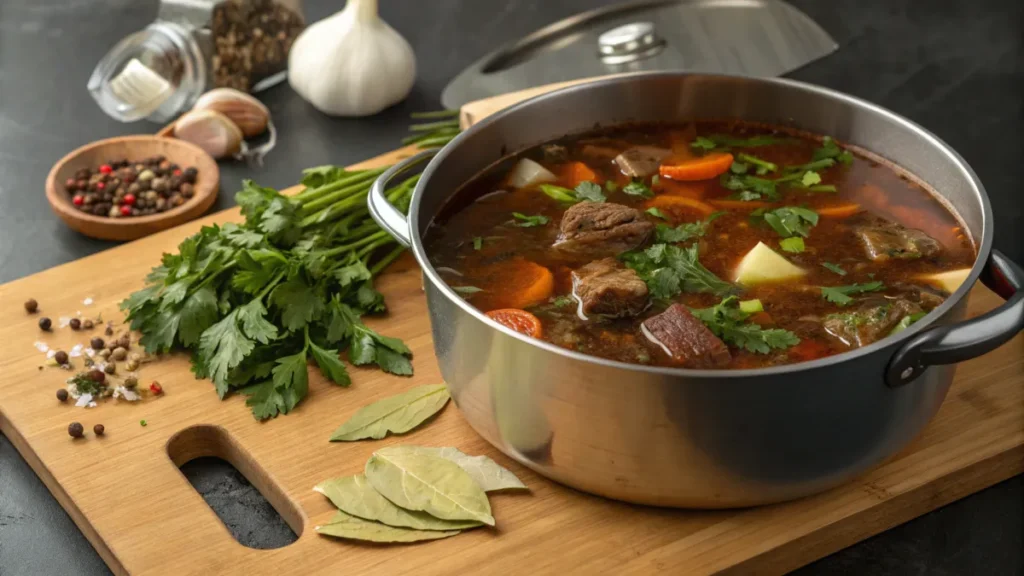
Adding more flavor to your vegetable soup is easy with the right ingredients. Start by sautéing onions, garlic, and carrots in a bit of olive oil before adding your other vegetables. This base will provide a rich, aromatic foundation. Herbs like thyme, rosemary, and bay leaves can also enhance the flavor. Add them early in the cooking process to allow their flavors to infuse into the soup. For a deeper taste, consider adding a splash of white wine or a spoonful of tomato paste. These ingredients will intensify the overall flavor profile. Additionally, a pinch of red pepper flakes can add a subtle kick without making the soup too spicy. Finally, don’t forget to season with salt and pepper to taste. These simple additions will transform your vegetable soup into a flavorful delight.
The Most Flavorful Beef for Soup is Chuck Roast
The most flavorful beef for soup is chuck roast. This cut of beef is known for its rich, beefy flavor and tender texture, making it perfect for slow-cooked soups and stews. Chuck roast comes from the shoulder area of the cow, which is well-exercised, resulting in a marbled meat that becomes incredibly tender and flavorful when cooked slowly. The marbling in chuck roast melts during the cooking process, adding depth and richness to the soup. Whether you’re making a classic beef and vegetable soup or a hearty beef stew, chuck roast will provide the robust flavor you’re looking for. Its affordability and versatility make it a popular choice for many beef-based soups.
Adding More Flavor to Beef Soup is Simple with These Techniques
Adding more flavor to beef soup is simple with the right techniques. Start by browning the beef before adding it to the soup. Browning creates a delicious, caramelized crust on the meat that enhances the overall flavor of the soup. Additionally, sautéing aromatics like onions, garlic, and celery in the same pot used to brown the beef will deglaze the pan, releasing those flavorful bits into your soup. Herbs such as thyme, rosemary, and bay leaves can also be added to the soup for extra depth. For a richer taste, consider adding a splash of red wine or beef broth. These liquids will intensify the beefy flavor and add complexity to your soup. Finally, let the soup simmer slowly to allow all the flavors to meld together, resulting in a hearty and flavorful beef soup.
You Can Fix Bland Vegetable Beef Soup with These Easy Steps
You can fix bland vegetable beef soup with these easy steps. First, taste your soup and identify what’s missing. Often, a pinch of salt and pepper can make a big difference. If the soup still lacks flavor, try adding more aromatics like garlic, onions, or herbs. Sautéing these ingredients in a bit of olive oil before adding them to the soup will release their flavors and enhance the overall taste. For a richer flavor, consider adding a splash of Worcestershire sauce or a spoonful of tomato paste. These ingredients will provide a depth of flavor that can transform your soup. Additionally, letting the soup simmer for a longer period can help the flavors meld together more intensely. If your soup is too watery, reducing it by letting some of the liquid evaporate will concentrate the flavors.
Conclusion
An old-fashioned vegetable beef soup recipe is more than just a dish it’s a tradition that brings warmth, comfort, and nostalgia to your table. With its wholesome ingredients and customizable nature, this classic soup has stood the test of time, adapting to every family’s preference and dietary needs.
Whether you’re savoring it with crusty bread on a chilly evening or tweaking it to fit a special diet, this soup is a timeless reminder of the joys of homemade cooking. Plus, it’s easy to prepare, store, and reheat, making it a go-to meal for busy weeknights or leisurely weekends.
Now it’s your turn to bring this beloved recipe to life. Gather your ingredients, follow the steps, and enjoy the rich, hearty flavors that make this soup a favorite in kitchens everywhere. Happy cooking!

